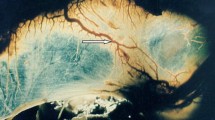Abstract
Purpose
Few studies have characterized the venous channels of the falx cerebri under physiological conditions. The present study aimed to explore the falx cerebri using magnetic resonance imaging (MRI).
Methods
A total of 91 patients (41 men and 50 women) with an intact falx cerebri and relevant dural sinuses underwent contrast MRI.
Results
In 15% of the participants, the falx cerebri contained venous channels with a patchy appearance. Seven of these channels were located in the anterior third of the falx, two were in the anterior two-thirds, and 5 were in the middle third. In 19 (21%) participants, the falcine sinus was unequivocally delineated. In 14 of them, connected the posterior third of the superior sagittal sinus and uppermost part of the straight sinus. These sinuses showed variable morphologies, presenting with linear, triangular, multi-channel, and branching appearances. The linear type was the most predominant and found in 50% of these cases. In contrast, in the remaining five participants, the falcine sinuses were coursing posteriorly, connecting the posterior third of the falx cerebri with the superior sagittal sinus.
Conclusion
The falx cerebri may have a role as a pathway in the intracranial venous circulation. The falcine sinus has several variants with diverse morphologies.




Similar content being viewed by others
References
Bartels RH, Merx JL, van Overbeeke JJ (1998) Falcine sinus and occipital encephalocele: a magnetic resonance venography study. J Neurosurg 89:738–741
Bekci T, Bilgici MC, Gunbey HP (2016) Incidental persistent falcine sinus. Pediatr Neurol 56:90–91
Kaplan HA, Browder J, Krieger AJ (1975) Venous channels within the intracranial dural partitions. Radiology 115:641–645
Kashimura H, Arai H, Ogasawara K, Ogawa A (2007) Persistent falcine sinus associated with obstruction of the superior sagittal sinus caused by meningioma–case report. Neurol Med Chir (Tokyo) 47:83–84
Kędzia W, Kędzia E, Kędzia A, Derkowski W (2017) Anatomy of the falcine sinus during the prenatal period. Surg Radiol Anat 39:753–758
Lin L, Lin JH, Guan J, Zhang XL, Chu JP, Yang ZY (2018) Falcine sinus: Incidence and imaging characteristics of three-dimensional contrast-enhanced thin-section magnetic resonance imaging. Korean J Radiol 19:463–469
Mizutani K, Miwa T, Akiyama T, Sakamoto Y, Fujiwara H, Yoshida K (2018) Fate of the three embryonic dural sinuses in infants: the primitive tentorial sinus, occipital sinus, and falcine sinus. Neuroradiology 60:325–333
Ryu CW (2010) Persistent falcine sinus: is it really rare? AJNR Am J Neuroradiol 31:367–369
Sener RN (2000) Association of persistent falcine sinus with different clinicopathologic conditions: MR imaging and MR angiography. Comput Med Imaging Graph 24:343–346
Smith A, Choudhary AK (2014) Prevalence of persistent falcine sinus as an incidental finding in the pediatric population. AJR Am J Roentgenol 203:424–425
Strub WM, Leach JL, Tomsick TA (2005) Persistent falcine sinus in an adult: demonstration by MR venography. AJNR Am J Neuroradiol 26:750–751
Tatarli N, Ceylan D, Canaz H, Tokmak M, Bay HH, Şeker A, Keleş E, Kiliç T, Cavdar S (2013) Falcine venous plexus within the falx cerebri: anatomical and scanning electron microscopic findings and clinical significance. Acta Neurochir (Wien) 155:2183–2189
Tubbs RS, Loukas M, Louis RG Jr., Shoja MM, Acakpo-Satchivi L, Blount JP, Salter EG, Oakes WJ, Wellons JC (2007) Anatomy of the falcine venous plexus. J Neurosurg 107:155–157
Varma DR, Reddy BC, Rao RV (2008) Recanalization and obliteration of falcine sinus in cerebral venous sinus thrombosis. Neurology 70:79–80
Yoshioka S, Moroi J, Kobayashi S, Furuya N, Ishikawa T (2013) A case of falcine sinus arteriovenous fistula. Neurosurgery 73:E554–E556
Acknowledgements
This work was not supported by grant funding through any government/private agencies.
Author information
Authors and Affiliations
Contributions
ST proposed the project of study. HI and YY collected the imaging data. HO and HI analyzed the imaging data. ST wrote the manuscript. All the authors equally contributed to the study.
Corresponding author
Ethics declarations
Conflict of interest
The authors have no conflicts of interest concerning the materials or methods used in this study or the findings presented in this paper.
Rights and permissions
About this article
Cite this article
Tsutsumi, S., Ono, H., Yasumoto, Y. et al. Venous channels of the falx cerebri in adult Japanese population: delineation using magnetic resonance imaging. Surg Radiol Anat 41, 203–207 (2019). https://doi.org/10.1007/s00276-018-2146-6
Received:
Accepted:
Published:
Issue Date:
DOI: https://doi.org/10.1007/s00276-018-2146-6




